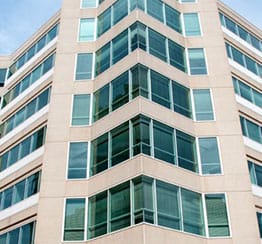
If you found yourself sniffling and sneezing through the spring in 2014, this year may not be too different. AccuWeather reported that 2015 will look a lot like 2014 when it comes to spring allergies.
Like last year, 2015 will have delayed tree pollen release in much of the Northeast because of the rough winter. This doesn't mean that there's more pollen than normal, but it can last longer than normal. Peak allergies around the Virginia, Maryland and Delaware area hit in the early to middle of May. In New Jersey, New York and New England, peak allergies are expected in early June.
Whether from grass, flowers, shrubs or trees, pollen is plentiful in the spring and can blow onto any building or structure when the weather is right. This year, prepare for and fight off this annoying substance which can cause allergies for your tenants, problems for your building and headaches for you. Here are a few techniques that you can use to combat pollen this spring and summer.

Know the weather warning signs
Pollen is a powdery substance used by plants to reproduce. It should be harmless to people, however, many are allergic to the substance, meaning that their body overreacts to exposure as if it were a virus or bacteria. People are most at risk of allergies when there's a high percentage of pollen in the air, also called a pollen count. This when it's most important to guard your tenants and building against this springtime hassle.
Rain can be beneficial because it washes pollen away, but it also stimulates the production of more pollen which could lead to worse allergies in a day or two. So, keep an eye out for pollen on dry, windy days as well as directly after a storm.
Clean you windows
For a building or facilities manager, the worst part about pollen season is how it can cake a building with unsightly yellow powder. This powder can create stains in as it dries to the window and even streaks when rain hits it.
"Keep your windows washed to keep pollen at bay."
Talk to Clean and Polish Building Solutions about having regular window washing during the times when pollen is at it's highest. Even if every building around yours looks dirty and yellow, your building can still look professional and presentable.
Check your HVAC and caulking
The pollen outside shouldn't be affecting the tenants once they're inside your building, but sometimes that's easier said than done. The U.S. Centers for Disease Control and Prevention noted that when outdoor air quality is suboptimal, like when there's a high pollen count, it can fall on your ventilation or HVAC system to do the work. Take this opportunity to check your filters and make sure that it's all working properly.
Like with heating in the winter or cooling in the summer, pollen can also get into your building if there are flaws in its envelope. Check at joints, around windows and in the more risky places to ensure that their aren't any air leaks. Have extra caulking applied where needed.
Have your exterior washed
It's not just the filters and windows that get filthy with too much pollen in the air, the awnings, flags and banners do too. Have these cloth features, as well as sidewalks, facades and any other exterior factors cleaned professionally when allergy season is over so that your building looks perfect all summer long. You don't want a yellow-stained awning in front of your building.


